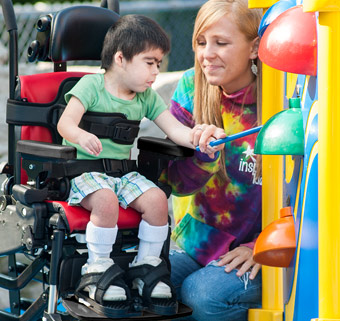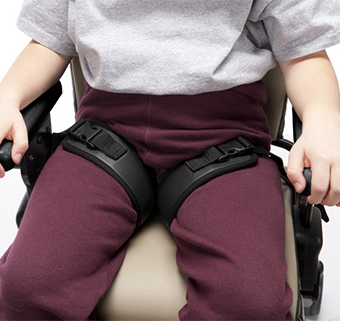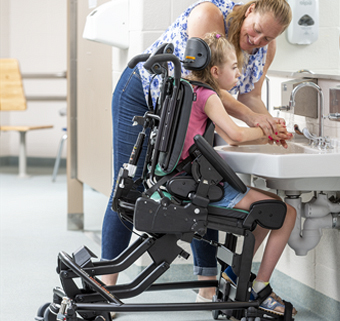Positioning for Active Sitting
Lori Potts, PT discusses positioning concepts for active sitting and demonstrates them using the Rifton Activity Chair.
Hello, my name is Lori Potts, physical therapist with Rifton. Today we are going to talk about active, functional sitting – which is different than passive sitting – and how to position to achieve that with the Rifton Activity Chair.
The Upright Position
Here we see a chair that s in the reclined position, with the posterior tilt and the backrest reclined. Good for pressure relief or resting when digesting; but for active, functional sitting we will want the chair in a more upright position. The important thing is to get the seat depth, and that is adjusted here, so that we have clearance behind the knees. Another important aspect is the seat width, which we can use these hip guides to adjust; because this really is your weight-bearing surface, and we want that to be stable for the child. The seat belt can hold them in the back of the seat, or we can use this pelvic harness – and this has a strap that comes around the inside of the thigh and buckles securely, also then contributing to some leg separation. Because hip abduction is important for active, functional sitting as well. And we have the leg prompt and the hip abductor, which can also assure that hip abduction.
The Footboard
The next very important aspect is the footrest; and we can adjust the angle and the depth, because we want to be sure that the child has very secure foot positioning. We can also adjust the angle of the footboard. The child will be sharing some of their weight through their feet as well as through their posterior thighs.
The Backrest
Then we have the possibility of adjusting the backrest angle and the seat tilt. The backrest angle can actually be open slightly, and then find the best position for the seat that will enable the child s postural and head control, with their line of gravity. At first they may not be able to manage much more than close to horizontal, but eventually we would like to bring them into anterior tilt and see if that might help improve their reaching. We can also use a tray for them to place their forearms on the surface, and that will contribute to some weight bearing through the arms and better control of their upper trunk and head as they work on their active sitting and their postural control.
Initiating Active Weight Bearing
Beyond this, we can also use the chair as a way to initiate some early active weight bearing. And the way we do that is that we bring the backrest all the way open and the seat all the way forward, and then encourage some active weight bearing through the legs and through the arms. So the child is actually pushing through their feet to help keep their hips in the back of the chair and getting some early weight bearing. Another functional position is to actually move the footrest back out of the way and to encourage the child to get their feet on the floor and to stand up directly from the chair. So with active sitting, we re encouraging the child s own postural strength and head control over time with practice.
To learn more about the accessories available with the Rifton Activity Chair, please contact our customer service, and all the best as you work on these ideas with your child with special needs.




